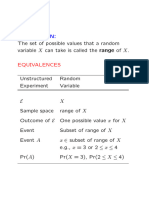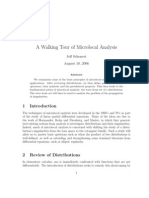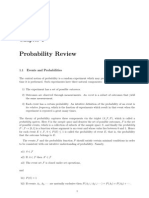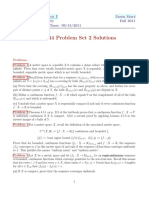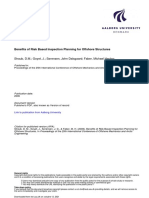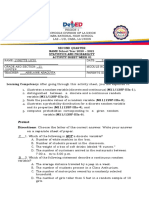5 Continuous Random Variables
5 Continuous Random Variables
Uploaded by
Aaron LeãoCopyright:
Available Formats
5 Continuous Random Variables
5 Continuous Random Variables
Uploaded by
Aaron LeãoOriginal Title
Copyright
Available Formats
Share this document
Did you find this document useful?
Is this content inappropriate?
Copyright:
Available Formats
5 Continuous Random Variables
5 Continuous Random Variables
Uploaded by
Aaron LeãoCopyright:
Available Formats
5 Continuous random variables
We deviate from the order in the book for this chapter, so the subsections in
this chapter do not correspond to those in the text.
5.1 Densities of continuous random variable
Recall that in general a random variable X is a function from the sample
space to the real numbers. If the range of X is nite or countable innite,
we say X is a discrete random variable. We now consider random variables
whose range is not countably innite or nite. For example, the range of X
could be an interval, or the entire real line.
For discrete random variables the probability mass function is f
X
(x) =
P(X = x). If we want to compute the probability that X lies in some set,
e.g., an interval [a, b], we sum the pmf:
P(a X b) =
x:axb
f
X
(x)
A special case of this is
P(X b) =
x:xb
f
X
(x)
For continuous random variables, we will have integrals instead of sums.
Denition 1. A random variable X is continuous if there is a non-negative
function f
X
(x), called the probability density function (pdf ) or just density,
such that
P(X t) =
_
t
f
X
(x) dx
Proposition 1. If X is a continuous random variable with density f(x),
then
1. P(X = x) = 0 for any x R.
2. P(a X b) =
_
b
a
f(x) dx
3. For any subset C of R, P(X C) =
_
C
f(x) dx
1
4.
_
f(x) dx = 1
Proof. First we observe that subtracting the two equations
P(X b) =
_
b
f
X
(x) dx, P(X a) =
_
a
f
X
(x) dx
gives
P(X b) P(X a) =
_
b
a
f
X
(x) dx
and we have P(X b) P(X a) = P(a < X b), so
P(a < X b) =
_
b
a
f
X
(x) dx (1)
Now for any n
P(X = x) P(x 1/n < X x) =
_
x
x1/n
f
X
(t) dt
As n , the integral goes to zero, so P(X = x) = 0.
Property 2 now follows from eq. (1) since
P(a X b) = P(a < X b) +P(X = a) = P(a < X b)
Note that since the probability X equals any single real number is zero,
P(a X b), P(a < X b), P(a X < b), and P(a < X < b) are all the
same.
Property 3 is easy if C is a disjoint union of intervals. For more general
sets, it is not clear what
_
C
even means. This is beyond the scope of this
course.
Property 4 is just the fact that P(< X < ) = 1.
Caution Often the range of X is not the entire real line. Outside of the
range of X the density f
X
(x) is zero. So the denition of f
x
(x) will typically
involves cases: in one region it is given by some formula, elsewhere it is simply
0. So integrals over all of R which contain f
X
(x) will reduce to intervals over
a subset of R. If you mistakenly integrate the formula over the entire real
line you will of course get nonsense.
2
5.2 Catalog
As with discrete RVs, two continuous RVs dened on completely dierent
probability spaces can have the same density. And there are certain densities
that come up a lot. So we start a catalog of them.
Uniform: (two parameters a, b R with a < b) The uniform density on
[a, b] is
f(x) =
_
1
ba
, if a x b
0, otherwise
We have seen the uniform before. Previously we said that to compute the
probability X is in some subinterval [c, d] of [a, b] you take the length of that
subinterval divided by the length of [a, b]. This is of course what you get
when you compute
_
d
c
f
X
(x) dx =
_
d
c
1
b a
dx =
d c
b a
Exponential: (one real parameter > 0 )
f(x) =
_
e
x
, if x 0
0, if x < 0
Check that its total integral is 1. Note that the range is [0, ).
Normal: (two real parameters , > 0 )
f(x) =
1
2
exp
_
1
2
_
x
_
2
_
The range of a normal RV is the entire real line. It is anything but obvious
that the integral of this function is 1. Try to show it.
Cauchy:
f(x) =
1
(1 +x
2
)
3
Example: Suppose X is a random variable with an exponential distribution
with parameter = 2. Find P(X 2) and P(X 1|X 2).
Example: Suppose X has the Cauchy distribution. Find the number c with
the property that P(X c) = 1/4.
Example: Suppose X has the density
f(x) =
_
c x(2 x) if 0 x 2
0 otherwise
where c is a constant. Find the constant c and then compute P(1/2 X).
5.3 Expected value
A rigorous treatment of the expected value of a continuous random variable
requires the theory of abstract Lebesgue integration, so our discussion will
not be rigorous.
For a discrete RV X, the expected value is
E[X] =
x
xf
X
(x)
We will use this denition to derive the expected value for a continuous RV.
The idea is to write our continuous RV as the limit of a sequence of discrete
RVs.
Let X be a continuous RV. We will assume that it is bounded. So there is
a constant M such that the range of X lies in [M, M], i.e., M X M.
Fix a positive integer n and divide the range into subintervals of width 1/n.
In each of these subintervals we round the value of X to the left endpoint
of the interval and call the resulting RV X
n
. So X
n
is dened by
X
n
() =
k
n
, where k is the integer with
k
n
X() <
k + 1
n
Note that for all outcomes , |X() X
n
()| 1/n. So X
n
converges to X
pointwise on the sample space . In fact it converges uniformly on . The
expected value of X should be the limit of E[X
n
] as n .
The random variable X
n
is discrete. Its values are k/n with k running
from Mn to Mn 1 (or possibly a smaller set). So
E[X
n
] =
Mn1
k=Mn
k
n
f
Xn
(
k
n
)
4
Now
f
Xn
(
k
n
) = P(X
n
=
k
n
) = P(
k
n
X() <
k + 1
n
) =
_ k+1
n
k
n
f
X
(x) dx
So
E[X
n
] =
Mn1
k=Mn
k
n
_ k+1
n
k
n
f
X
(x) dx
=
Mn1
k=Mn
_ k+1
n
k
n
k
n
f
X
(x) dx
When n is large, the integrals in the sum are over a very small interval. In
this interval, x is very close to k/n. In fact, they dier by at most 1/n. So
the limit as n of the above should be
Mn1
k=Mn
_ k+1
n
k
n
xf
X
(x) dx =
_
M
M
xf
X
(x) dx =
_
xf
X
(x) dx
The last equality comes from the fact that f
X
(x) is zero outside [M, M].
So we make the following denition
Denition 2. Let X be a continuous RV with density f
X
(x). The expected
value of X is
E[X] =
_
xf
X
(x) dx
provided
_
|x| f
X
(x) dx <
(If this last integral is innite we say the expected value of X is not dened.)
The variance of X is
2
= E[(X )
2
], = E[X]
provided the expected value is dened.
5
End of September 30 lecture
Just as with discrete RVs, if X is a continuous RV and g is a function
fromR to R, then we can dene a new RV by Y = g(X). How do we compute
the mean of Y ? One approach would be to work out the density of Y and
then use the denition of expected value. We have not yet seen how to nd
the density of Y , but for this question there is a shortcut just as there was
for discrete RV.
Theorem 1. Let X be a continuous RV, g a function from R to R. Let
Y = g(X). Then
E[Y ] = E[g(X)] =
_
g(x) f
X
(x) dx
Proof. Since we do not know how to nd the density of Y , we cannot prove
this yet. We just give a non-rigorous derivation. Let X
n
be the sequence of
discrete RVs that approximated X dened above. Then g(X
n
) are discrete
RVs. They approximate g(X). In fact, if the range of X is bounded and g is
continous, then g(X
n
) will converge uniformly to g(X). So E[g(X
n
)] should
converges to E[g(X)].
Now g(X
n
)] is a discrete RV, and by the law of the unconscious statistician
E[g(X
n
)] =
x
g(x) f
Xn
(x) (2)
Looking back at our previous derivation we see this is
E[g(X
n
)] =
Mn1
k=Mn
g(
k
n
)
_ k+1
n
k
n
f
X
(x) dx
=
Mn1
k=Mn
_ k+1
n
k
n
g(
k
n
) f
X
(x) dx
which converges to
_
g(x) f
X
(x) dx (3)
6
Example: Find the mean and variance of the uniform distribution on [a, b].
The mean is
=
_
b
a
xf(x) dx =
_
b
a
x
b a
dx =
1
2
b
2
a
2
b a
=
a + b
2
(4)
For the variance we have to rst compute
E[X
2
] =
_
b
a
x
2
f(x) dx (5)
We then subtract the square of the mean and nd
2
= (b a)
2
/12.
Example: Find the mean and variance of the normal distribution.
Example: Find the mean of the Cauchy distribution
The gamma function is dened by
(w) =
_
0
x
w1
e
x
dx (6)
The gamma distribution has range [0, ) and depends on two parameters
> 0, w > 0. The density is
f(x) =
_
w
(w)
x
w1
e
x
if x 0
0 otherwise
(7)
In one of the homework problems we compute its mean and variance. You
should nd that they are
=
w
,
2
=
w
2
(8)
Example: Let X be exponential with parameter . Let Y = X
2
. Find the
mean and variance of Y .
5.4 Cumulative distribution function
In this section X is a random variable that can be either discrete or contin-
uous.
Denition 3. The cumulative distribution function (cdf ) of the random vari-
able X is the function
F
X
(x) = P(X x)
7
Why introduce this function? It will be a powerful tool when we look at
functions of random variables and compute their density.
Example: Let X be uniform on [1, 1]. Compute the cdf.
GRAPH !!!!!!!!!!!!!!!!!!!!
Example: Let X be a discrete RV whose pmf is given in the table.
x 2 3 4 5 6
f
X
(x) 1/8 1/8 3/8 2/8 1/8
GRAPH !!!!!!!!!!!!!!!!!!!!
Example: Compute cdf of exponential distribution.
Theorem 2. For any random variable the cdf satises
1. F(x) is non-decreasing, 0 F(x) 1.
2. lim
x
F(x) = 0, lim
x
F(x) = 1.
3. F(x) is continuous from the right.
4. For a continuous random variable the cdf is continuous.
5. For a discrete random variable the cdf is piecewise constant. The points
where it jumps is the range of X. If x is a point where it has a jump,
then the height of the jump is P(X = x).
Proof. 1 is obvious ....
To prove 2, let x
n
. Assume that x
n
is increasing. Let E
n
= {X
x
n
}. Then E
n
is in increasing sequence of events. By the continuity of the
probability measure,
P(
n=1
E
n
) = lim
n
P(E
n
)
Since x
n
, every outcome is in E
n
for large enough n. So
n=1
E
n
= .
So
lim
n
F(x
n
) = lim
n
P(E
n
) = 1 (9)
8
The proof that the limit as x is 0 is similar.
GAP
Now consider a continuous random variable X with density f. Then
F(x) = P(X x) =
_
x
f(t) dt
So given the density we can compute the cdf by doing the above integral.
Dierentiating the above we get
F
(x) = f(x)
So given the cdf we can compute the density by dierentiating.
Theorem 3. Let F(x) be a function from R to [0, 1] such that
1. F(x) is non-decreasing.
2. lim
x
F(x) = 0, lim
x
F(x) = 1.
3. F(x) is continuous from the right.
Then F(x) is the cdf of some random variable, i.e., there is a probability
space (, F, P) and a random variable X on it such that F(x) = P(X x).
f
The proof of this theorem is way beyond the scope of this course.
5.5 Function of a random variable
Let X be a continuous random variable and g : R R. Then Y = g(X) is
a new random variable. We want to nd its density. This is not as easy as
in the discrete case. In particular f
Y
(y) is not
x:g(x)=y
f
X
(x).
Key idea: Compute the cdf of Y and then dierentiate it to get the pdf of
Y .
Example: Let X be uniform on [0, 1]. Let Y = X
2
. Find the pdf of Y .
!!!!!!! GAP
Example: Let X be uniform on [1, 1]. Let Y = X
2
. Find the pdf of Y .
9
!!!!!!! GAP Example: Let X be uniform on [0, 1]. Let > 0. Y =
ln(X). Show Y has an exponential distribution.
!!!!!!! GAP Example: The standard normal distribution is the
normal distribution with = 0 and = 1. Let X have a normal distribution
with parameters and . Show that Z = (X)/ has the standard normal
distribution.
!!!!!!! GAP
Proposition 2. (How to write a general random number generator) Let X be
a continuous random variable with values in [a, b]. Suppose that the cdf F(x)
is strictly increasing on [a, b]. Let U be uniform on [0, 1]. Let Y = F
1
(U).
Then X and Y are identically distributed.
Proof.
P(Y y) = P(F
1
(U) y) = P(U F(y)) = F(y) (10)
Application:My computer has a routine to generate random numbers that
are uniformly distributed on [0, 1]. We want to write a routine to generate
numbers that have an exponential distribution with parameter .
How do you simulate normal RVs? Not so easy since the cdf cannot be
explicitly computed. More on this later.
5.6 More on expected value
Recall that for a discrete random variable that only takes on values in
0, 1, 2, , we showed in a homework problem that
E[X] =
k=0
P(X > k) (11)
There is a similar result for non-negative continuous random variables.
Theorem 4. Let X be a non-negative continuous random variable with cdf
F(x). Then
E[X] =
_
0
[1 F(x)] dx (12)
provided the integral converges.
10
Proof. We use integration by parts on the integral. Let u(x) = 1 F(x) and
dv = dx. So du = fdx and v = x. So
_
0
[1 F(x)] dx = x(1 F(x))|
x=0
+
_
0
xf(x) dx = E[X] (13)
Note that the boundary term at is zero since F(x) 1 as x .
We can use the above to prove the law of the unconscious statistician for
a special case. We assume that X 0 and that the function g is from [0, )
into [0, ) and it strictly increasing. Note that this implies that g has an
inverse. Then
E[Y ] =
_
0
[1 F
Y
(x)] dx =
_
0
[1 P(Y x)] dx (14)
=
_
0
[1 P(g(X) x)] dx =
_
0
[1 P(X g
1
(x))] dx (15)
=
_
0
[1 F
X
(g
1
(x))] dx (16)
Now we do a change of variables. Let s = g
1
(x). So x = g(s) and dx =
g
(s)ds. So above becomes
_
0
[1 F
X
(s)] g
(s) ds (17)
Now integrate this by parts to get
[1 F
X
(s)] g(s)|
s=0
+
_
0
g(s) f(s) ds (18)
which proves the theorem in this special case.
11
You might also like
- Class6 Prep ADocument7 pagesClass6 Prep AMariaTintashNo ratings yet
- Chapter 4Document36 pagesChapter 4Sumedh KakdeNo ratings yet
- Class Notes 3Document18 pagesClass Notes 3manmohanchaurasiya791No ratings yet
- The Uniform DistributnDocument7 pagesThe Uniform DistributnsajeerNo ratings yet
- Chapter 5Document19 pagesChapter 5chilledkarthikNo ratings yet
- Class Notes 2Document18 pagesClass Notes 2manmohanchaurasiya791No ratings yet
- Lesson 4 - Continuous Probability Distributions (With Exercises)Document16 pagesLesson 4 - Continuous Probability Distributions (With Exercises)crisostomo.neniaNo ratings yet
- Continuous FunctionsDocument19 pagesContinuous Functionsap021No ratings yet
- Introductory Probability and The Central Limit TheoremDocument11 pagesIntroductory Probability and The Central Limit TheoremAnonymous fwgFo3e77No ratings yet
- Chapter 2 - Random VariablesDocument26 pagesChapter 2 - Random VariablesNikhil SharmaNo ratings yet
- Week 6Document6 pagesWeek 6Gautham GiriNo ratings yet
- Chapter 4-6Document39 pagesChapter 4-6abiysemagn460No ratings yet
- Contractions: 3.1 Metric SpacesDocument10 pagesContractions: 3.1 Metric SpacesDaniel Sastoque BuitragoNo ratings yet
- James NotesDocument83 pagesJames NotesUmer HuzaifaNo ratings yet
- 1 Linearisation & DifferentialsDocument6 pages1 Linearisation & DifferentialsmrtfkhangNo ratings yet
- 408continuous PDFDocument2 pages408continuous PDFjorgeNo ratings yet
- Schoner TDocument12 pagesSchoner TEpic WinNo ratings yet
- Matrix Calculus: 1 The DerivativeDocument13 pagesMatrix Calculus: 1 The Derivativef270784100% (1)
- Lecture Notes Week 1Document10 pagesLecture Notes Week 1tarik BenseddikNo ratings yet
- Stable Manifold TheoremDocument7 pagesStable Manifold TheoremRicardo Miranda MartinsNo ratings yet
- Contraction PrimeneDocument19 pagesContraction PrimeneMarko BerarNo ratings yet
- Hitchhiker S Guide To ProbabilityDocument6 pagesHitchhiker S Guide To ProbabilityMatthew RaymondNo ratings yet
- RV IntroDocument5 pagesRV IntroBalajiNo ratings yet
- Probability Distributions: Discrete and Continuous Univariate Probability Distributions. Let S Be A Sample Space With A ProbDocument7 pagesProbability Distributions: Discrete and Continuous Univariate Probability Distributions. Let S Be A Sample Space With A ProbmustafaNo ratings yet
- Chapter 4Document21 pagesChapter 4Anonymous szIAUJ2rQ080% (5)
- R Is Uncountable Using The Intermediate Value TheoremDocument4 pagesR Is Uncountable Using The Intermediate Value Theorembindeshwariprasad1No ratings yet
- Stationary Points Minima and Maxima Gradient MethodDocument8 pagesStationary Points Minima and Maxima Gradient MethodmanojituuuNo ratings yet
- An Informal Introduction To Stochastic Calculus With ApplicationsDocument10 pagesAn Informal Introduction To Stochastic Calculus With ApplicationsMarjo KaciNo ratings yet
- 2 Discrete Random Variables: 2.1 Probability Mass FunctionDocument12 pages2 Discrete Random Variables: 2.1 Probability Mass FunctionAdry GenialdiNo ratings yet
- 4.2. Sequences in Metric SpacesDocument8 pages4.2. Sequences in Metric Spacesmarina_bobesiNo ratings yet
- Maths ThoothorDocument57 pagesMaths ThoothorramNo ratings yet
- HMWK 4Document5 pagesHMWK 4Jasmine NguyenNo ratings yet
- Christian Remling: N N N J J P 1/pDocument11 pagesChristian Remling: N N N J J P 1/pJuan David TorresNo ratings yet
- Improper IntegralDocument23 pagesImproper IntegralPblock Saher100% (1)
- TOBB ETU ELE471: Lecture 1Document7 pagesTOBB ETU ELE471: Lecture 1Umit GudenNo ratings yet
- Class Notes 4Document14 pagesClass Notes 4manmohanchaurasiya791No ratings yet
- Banach Contraction PrincipleDocument3 pagesBanach Contraction PrincipleJames Tesen GarayNo ratings yet
- Heavy Duty Math Writing: 1 Utilizing Large DelimitersDocument9 pagesHeavy Duty Math Writing: 1 Utilizing Large DelimitersCurtis HelmsNo ratings yet
- STAT 538 Maximum Entropy Models C Marina Meil A Mmp@stat - Washington.eduDocument20 pagesSTAT 538 Maximum Entropy Models C Marina Meil A Mmp@stat - Washington.eduMatthew HagenNo ratings yet
- MAT 544 Problem Set 2 SolutionsDocument7 pagesMAT 544 Problem Set 2 SolutionsNaveen GuptaNo ratings yet
- CompleteDocument9 pagesCompleteJose MiguelNo ratings yet
- Practice Final Exam Solutions: 2 SN CF N N N N 2 N N NDocument7 pagesPractice Final Exam Solutions: 2 SN CF N N N N 2 N N NGilberth Barrera OrtegaNo ratings yet
- Chapter3-Discrete DistributionDocument141 pagesChapter3-Discrete DistributionjayNo ratings yet
- UntitledDocument9 pagesUntitledAkash RupanwarNo ratings yet
- Elements of Mathematical Analysis Author Harald Hanche-OlsenDocument31 pagesElements of Mathematical Analysis Author Harald Hanche-OlsenoumarjekaniNo ratings yet
- 6 Uniform Boundedness PrincipleDocument6 pages6 Uniform Boundedness PrincipleMiguel Angel Mora LunaNo ratings yet
- Metric Spaces: 4.1 CompletenessDocument7 pagesMetric Spaces: 4.1 CompletenessJuan Carlos Sanchez FloresNo ratings yet
- Handout2 BasicsOf Random VariablesDocument3 pagesHandout2 BasicsOf Random Variablesozo1996No ratings yet
- LECT3 Probability TheoryDocument42 pagesLECT3 Probability Theoryhimaanshu09No ratings yet
- Elements of Probability Theory: 2.1 Probability, Random Variables and Random MatricesDocument7 pagesElements of Probability Theory: 2.1 Probability, Random Variables and Random MatricesGerardOo Alexander SNo ratings yet
- Distribuciones de ProbabilidadesDocument10 pagesDistribuciones de ProbabilidadesPatricio Antonio VegaNo ratings yet
- R VariablesDocument9 pagesR VariablesMara Amei Marín RodenhorstNo ratings yet
- Probability ReviewDocument12 pagesProbability Reviewavi_weberNo ratings yet
- Chap2 PDFDocument20 pagesChap2 PDFJacobNo ratings yet
- Probability Theory Nate EldredgeDocument65 pagesProbability Theory Nate Eldredgejoystick2inNo ratings yet
- The Beamer Minimal Theme Black and White 1Document29 pagesThe Beamer Minimal Theme Black and White 1Anîl RåjpütNo ratings yet
- Slide Chap4Document19 pagesSlide Chap4dangxuanhuy3108No ratings yet
- CH 3Document22 pagesCH 3Agam Reddy MNo ratings yet
- STATICTICSDocument296 pagesSTATICTICSDhwani Desai0% (1)
- Junior DocsDocument3 pagesJunior Docsjevanjunior100% (1)
- Fin 254 - Chapter 8Document46 pagesFin 254 - Chapter 8sajedulNo ratings yet
- 5 - 3RD Term Napps Scheme For SS 1 - 3 2022 CollegeDocument72 pages5 - 3RD Term Napps Scheme For SS 1 - 3 2022 CollegemellychemaNo ratings yet
- The Standard Behavior Analysis GuidelinesDocument9 pagesThe Standard Behavior Analysis GuidelinesnickNo ratings yet
- Asbjorn Sen 1985Document3 pagesAsbjorn Sen 1985Davidsantiago Murillo AvilaNo ratings yet
- New Lesson 2a - Measure of Central TendencyDocument12 pagesNew Lesson 2a - Measure of Central Tendencyjhean dabatosNo ratings yet
- Probability in Casinos FinalDocument36 pagesProbability in Casinos FinalMuskan MishraNo ratings yet
- Online Free Ebooks Download 40 Paradoxes in Logic Probability and Game TheoryDocument4 pagesOnline Free Ebooks Download 40 Paradoxes in Logic Probability and Game TheoryAshok KumarNo ratings yet
- Chapter 7 Discrete ProbablityDocument24 pagesChapter 7 Discrete ProbablityMeketa WoldeslassieNo ratings yet
- Experts in UncertaintyDocument334 pagesExperts in Uncertaintyhambrosi3403100% (3)
- Benefits RBI Offshore StructuresDocument11 pagesBenefits RBI Offshore Structureswebs.usuarioNo ratings yet
- CS Profile Q Min CH El W.S. Elev Crit W.S. E.G. Elev E.G. Slope CV FA TW Fr. (M) (M) (M) (M) (M/M) (M/S) (M) (M /S) (M)Document41 pagesCS Profile Q Min CH El W.S. Elev Crit W.S. E.G. Elev E.G. Slope CV FA TW Fr. (M) (M) (M) (M) (M/M) (M/S) (M) (M /S) (M)Leo KhkNo ratings yet
- Simple Random Sampling With Over-Replacement: Erika Antal, Yves TilleDocument5 pagesSimple Random Sampling With Over-Replacement: Erika Antal, Yves TilleTasisa A WakumaNo ratings yet
- Operation Research BookDocument225 pagesOperation Research BookChaturvedi Vuchula100% (2)
- Stat and Prob Mod1February 21-26-2022 ANSWER SHEETDocument24 pagesStat and Prob Mod1February 21-26-2022 ANSWER SHEETLynette LicsiNo ratings yet
- Lect 5 Geometric DistributionDocument20 pagesLect 5 Geometric DistributionDEVANSHI MATHURNo ratings yet
- Notation in Probability and Statistics - WikipediaDocument13 pagesNotation in Probability and Statistics - WikipediaHussain BirmaniNo ratings yet
- Activity 2 - Chapter 1 Betty Mae FloresDocument4 pagesActivity 2 - Chapter 1 Betty Mae FloresBetty Mae FloresNo ratings yet
- Course Outline Eca 1,2 EtcDocument3 pagesCourse Outline Eca 1,2 EtcShahmeer KhanNo ratings yet
- Chapter 4Document148 pagesChapter 4Mehedi HasanNo ratings yet
- PSS 1 - MGMT331Document5 pagesPSS 1 - MGMT331Svetlana PetrosyanNo ratings yet
- Tabel PoisonDocument2 pagesTabel PoisonTitin Efi IdayatiNo ratings yet
- GEM2900: Understanding Uncertainty & Statistical Thinking: David NottDocument17 pagesGEM2900: Understanding Uncertainty & Statistical Thinking: David NottLanceNo ratings yet
- QP, P & S (Cse & It), Nov 10Document8 pagesQP, P & S (Cse & It), Nov 10bvs957946No ratings yet
- CS Ass-2-1 PDFDocument8 pagesCS Ass-2-1 PDFsyeda ume rubabNo ratings yet
- Probability II Form 5Document24 pagesProbability II Form 5azlina_4410No ratings yet
- Exercise Class No. 5 - Financial Mathematics I: Professor DR Peter Bank (Lecturer), Franziska Bielert (Assistant)Document3 pagesExercise Class No. 5 - Financial Mathematics I: Professor DR Peter Bank (Lecturer), Franziska Bielert (Assistant)josemoragmxNo ratings yet
- Randomvariables HandoutDocument13 pagesRandomvariables HandoutTrường Nguyễn HuyNo ratings yet
- Practice Problem - Set 2 Probability: Tutorial Ex. 1. Show ThatDocument2 pagesPractice Problem - Set 2 Probability: Tutorial Ex. 1. Show Thatmohamed salahNo ratings yet


